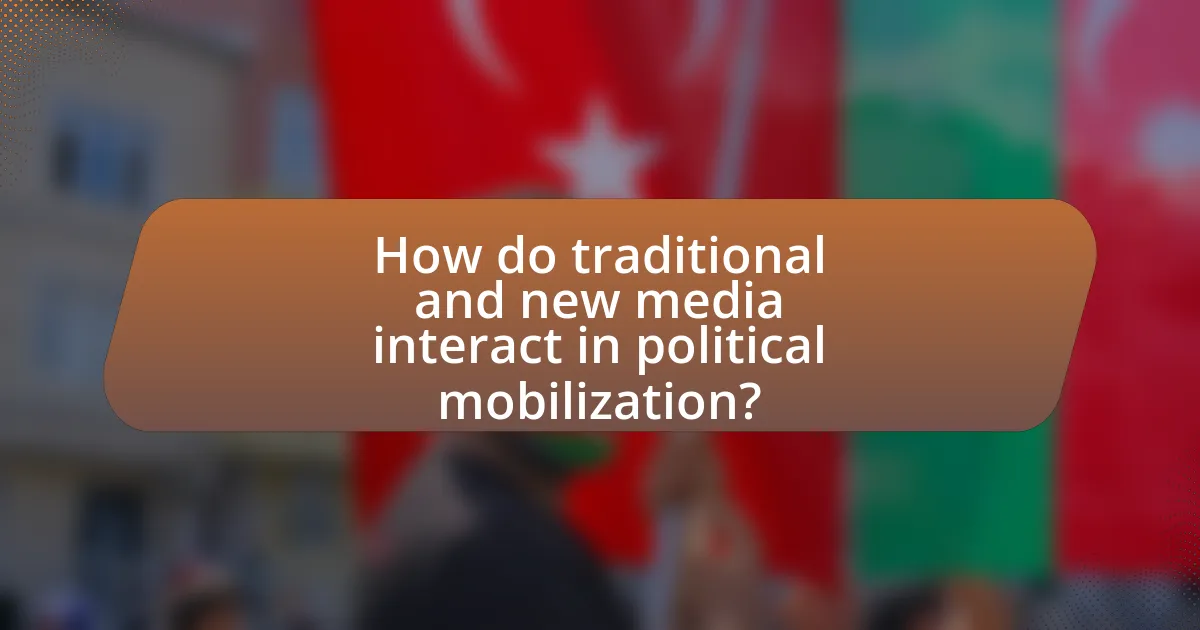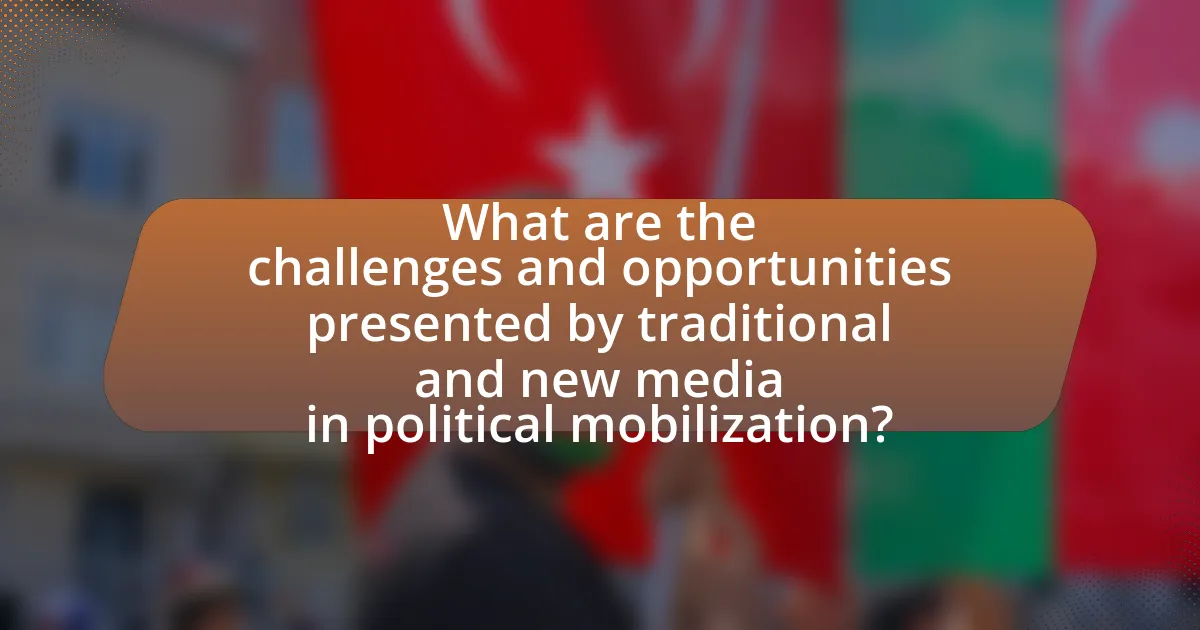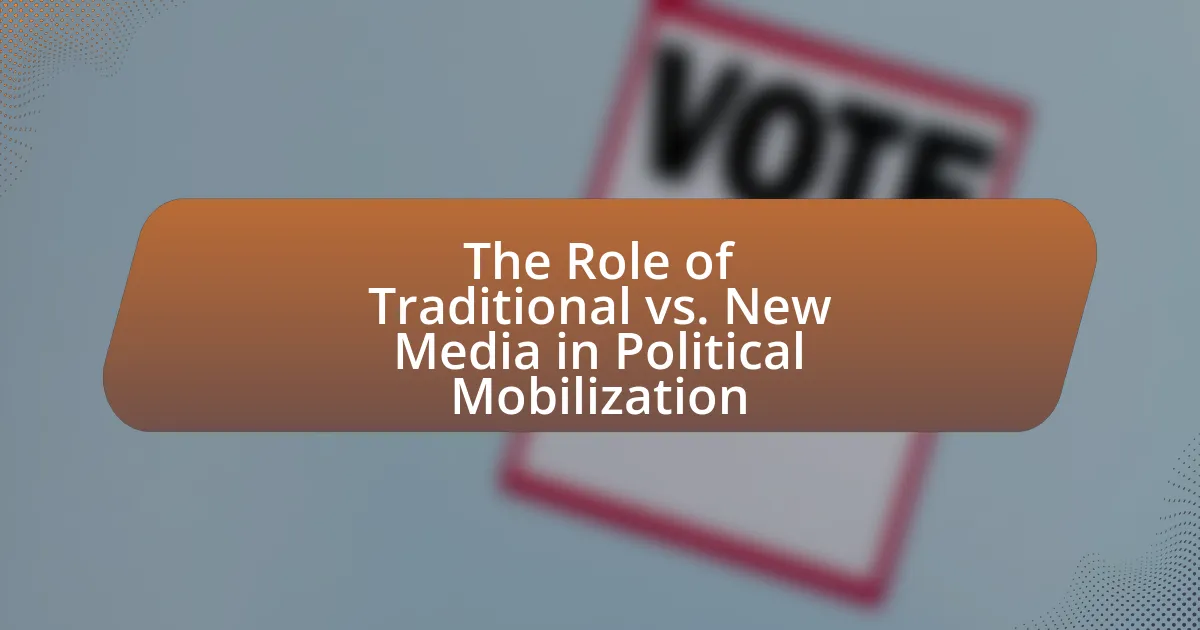The article examines the role of traditional and new media in political mobilization, highlighting their distinct yet complementary functions. Traditional media, including newspapers, television, and radio, shapes public opinion and facilitates political discourse through credible information dissemination. In contrast, new media, particularly social media platforms, enables rapid information sharing and grassroots organizing, effectively engaging younger demographics. The article discusses how both media types interact, the challenges they face, and the implications for political campaigns, emphasizing the importance of adapting strategies to leverage the strengths of each medium in mobilizing citizens for political action.

What is the Role of Traditional vs. New Media in Political Mobilization?
Traditional media, such as newspapers, television, and radio, plays a foundational role in political mobilization by providing broad access to information and shaping public opinion through established credibility. In contrast, new media, including social media platforms and online news outlets, facilitates rapid dissemination of information and enables grassroots organizing, allowing individuals to engage directly with political content and mobilize support quickly. For instance, during the Arab Spring, social media was pivotal in organizing protests and sharing real-time updates, demonstrating its effectiveness in mobilizing citizens. Studies indicate that new media can reach younger demographics more effectively, while traditional media remains influential among older populations, highlighting the complementary roles both forms of media play in political mobilization.
How do traditional media influence political mobilization?
Traditional media influence political mobilization by shaping public opinion and providing a platform for political discourse. Through news coverage, editorial content, and political advertisements, traditional media outlets inform citizens about political issues, candidates, and events, thereby facilitating engagement and participation in the political process. For instance, studies have shown that extensive media coverage of elections can significantly increase voter turnout; the Pew Research Center found that 61% of voters reported that news coverage influenced their decision to vote in the 2020 U.S. presidential election. Additionally, traditional media can amplify social movements by highlighting specific causes, as seen in the coverage of the Civil Rights Movement in the 1960s, which helped mobilize public support and action.
What are the key characteristics of traditional media in politics?
Traditional media in politics is characterized by its structured format, wide reach, and gatekeeping role. Traditional media includes newspapers, television, and radio, which provide curated content that shapes public opinion and political discourse. These media outlets often adhere to journalistic standards and practices, ensuring a level of credibility and authority in the information presented. For instance, according to the Pew Research Center, traditional media remains a primary source of news for a significant portion of the population, influencing voter behavior and political engagement. Additionally, traditional media often serves as a platform for political advertising, allowing candidates to communicate their messages to a broad audience, thereby playing a crucial role in electoral processes.
How does traditional media shape public opinion and political engagement?
Traditional media shapes public opinion and political engagement by providing a platform for information dissemination and framing narratives. Through news broadcasts, newspapers, and magazines, traditional media influences perceptions by selecting which stories to highlight, thereby guiding public discourse. For instance, studies have shown that media coverage of political events can significantly affect voter turnout; a report by the Pew Research Center found that 62% of Americans say they get their news from television, which often sets the agenda for political discussions. Additionally, traditional media can mobilize citizens by promoting civic participation through coverage of elections and political issues, as evidenced by historical events like the Civil Rights Movement, where media coverage galvanized public support and action.
What impact does new media have on political mobilization?
New media significantly enhances political mobilization by facilitating rapid information dissemination and fostering community engagement. Platforms such as social media enable individuals and organizations to share messages widely, mobilizing supporters quickly for events like protests or campaigns. For instance, during the Arab Spring, social media played a crucial role in organizing protests and spreading awareness, demonstrating how new media can galvanize public action. Additionally, studies indicate that online platforms increase political participation, particularly among younger demographics, as they provide accessible channels for political discourse and activism.
What are the defining features of new media in the political context?
New media in the political context is characterized by interactivity, immediacy, and accessibility. Interactivity allows users to engage with content and participate in discussions, fostering a two-way communication channel between politicians and constituents. Immediacy refers to the rapid dissemination of information, enabling real-time updates and responses to political events, as seen during events like the Arab Spring where social media played a crucial role in mobilization. Accessibility ensures that a broader audience can access political content through various platforms, including social media, blogs, and podcasts, which democratizes information and empowers grassroots movements. These features collectively enhance political engagement and mobilization, as evidenced by the significant role of platforms like Twitter and Facebook in recent electoral campaigns and social movements.
How does new media facilitate grassroots movements and activism?
New media facilitates grassroots movements and activism by providing platforms for rapid communication, organization, and mobilization of supporters. Social media networks like Twitter and Facebook enable activists to share information instantly, reach a global audience, and coordinate events without the need for traditional media gatekeepers. For instance, the Arab Spring in 2011 demonstrated how platforms like Facebook were instrumental in organizing protests and disseminating information, leading to significant political changes in several countries. Additionally, new media allows for the creation of viral campaigns, which can amplify messages and attract widespread attention, as seen in movements like #BlackLivesMatter, which gained momentum through social media engagement.
What are the differences between traditional and new media in political contexts?
Traditional media, such as newspapers, television, and radio, primarily deliver information in a one-way communication model, while new media, including social media platforms and blogs, facilitate interactive, two-way communication. Traditional media often has a longer production cycle and is subject to editorial control, which can limit the immediacy and diversity of viewpoints presented. In contrast, new media allows for real-time updates and a broader range of voices, enabling grassroots movements to mobilize quickly and effectively. For instance, during the Arab Spring, social media played a crucial role in organizing protests and disseminating information rapidly, demonstrating the power of new media in political contexts compared to the slower, more centralized nature of traditional media.
How do audience engagement strategies differ between traditional and new media?
Audience engagement strategies differ significantly between traditional and new media, primarily in their interactivity and immediacy. Traditional media, such as television and print, typically employ one-way communication, where audiences receive information passively without direct interaction. In contrast, new media platforms, like social media and websites, facilitate two-way communication, allowing audiences to engage actively through comments, shares, and real-time feedback.
For instance, a study by the Pew Research Center found that 72% of adults use social media to connect with one another, share information, and engage with content, highlighting the participatory nature of new media. This shift enables political mobilization efforts to harness audience feedback and adapt strategies quickly, unlike traditional media, which often requires longer lead times for content creation and dissemination.
What are the implications of these differences for political campaigns?
The differences between traditional and new media significantly impact political campaigns by shaping voter engagement strategies. Traditional media, such as television and print, often reach broader audiences but lack the interactive capabilities of new media platforms like social media, which allow for targeted messaging and real-time feedback. For instance, campaigns utilizing social media can engage younger voters more effectively, as 71% of millennials use social media for political information, compared to only 38% of older generations. This shift necessitates that political campaigns adapt their strategies to leverage new media for direct interaction, mobilization, and grassroots organizing, ultimately influencing voter turnout and campaign success.

How do traditional and new media interact in political mobilization?
Traditional and new media interact in political mobilization by complementing each other to enhance outreach and engagement. Traditional media, such as television and newspapers, provide credibility and reach to a broad audience, while new media, including social media platforms, facilitate rapid information dissemination and grassroots organizing. For instance, during the Arab Spring, traditional media reported on protests, while social media enabled real-time communication and mobilization among activists, demonstrating how both media types can synergistically amplify political messages and actions. This interaction is crucial for shaping public opinion and mobilizing support for political causes.
What role does social media play in amplifying traditional media messages?
Social media significantly amplifies traditional media messages by increasing their reach and engagement. When traditional media outlets share content on social platforms, they tap into vast networks of users who can further disseminate that information, leading to a multiplier effect. For instance, a study by the Pew Research Center found that 62% of adults in the U.S. get news from social media, indicating that these platforms serve as critical channels for traditional media content. Additionally, social media allows for real-time interaction and feedback, enabling audiences to engage with traditional media narratives, which can enhance visibility and influence public discourse.
How do traditional media adapt to the rise of new media in political reporting?
Traditional media adapt to the rise of new media in political reporting by integrating digital platforms and enhancing their online presence. This adaptation includes the development of websites and mobile applications that provide real-time news updates, allowing traditional outlets to compete with the immediacy of social media. For instance, major newspapers like The New York Times and The Washington Post have invested in digital subscriptions and multimedia content to engage audiences who increasingly consume news online. Additionally, traditional media organizations often utilize social media channels to disseminate their content, interact with audiences, and gather feedback, thereby fostering a more dynamic relationship with their viewers. This shift is evidenced by the fact that as of 2021, over 60% of adults in the U.S. reported getting news from social media platforms, prompting traditional media to adapt their strategies to maintain relevance in a rapidly evolving media landscape.

What are the challenges and opportunities presented by traditional and new media in political mobilization?
Traditional and new media present distinct challenges and opportunities in political mobilization. Traditional media, such as television and newspapers, often face challenges like declining audience engagement and the rise of misinformation, which can hinder effective communication of political messages. Conversely, traditional media offers established credibility and a broad reach, allowing for the dissemination of information to diverse demographics.
New media, including social media platforms, presents opportunities for rapid information sharing and grassroots mobilization, enabling political movements to gain momentum quickly. However, challenges such as echo chambers and the spread of fake news can distort political discourse and polarize audiences. Research indicates that social media can amplify political participation, with a study by the Pew Research Center showing that 69% of adults in the U.S. use social media, which can facilitate political engagement and activism.
In summary, while traditional media struggles with credibility and engagement, it maintains a broad reach, whereas new media fosters rapid mobilization but risks misinformation and polarization.
What challenges do traditional media face in the digital age?
Traditional media face significant challenges in the digital age, primarily due to the rise of online platforms that offer instant access to information. This shift has led to a decline in traditional advertising revenue, as advertisers increasingly prefer digital channels that provide targeted reach and measurable results. According to a Pew Research Center report, in 2020, digital ad spending surpassed traditional media ad spending for the first time, highlighting the financial pressures on traditional outlets. Additionally, the rapid dissemination of information through social media has diminished the audience’s reliance on traditional news sources, resulting in decreased viewership and readership. This trend is further exacerbated by the prevalence of misinformation online, which undermines the credibility of established media organizations.
How does the decline of traditional media affect political discourse?
The decline of traditional media negatively affects political discourse by reducing the diversity of viewpoints and diminishing the quality of information available to the public. As traditional media outlets, such as newspapers and broadcast news, face financial challenges and audience decline, they often cut back on investigative journalism and in-depth reporting, leading to a reliance on sensationalism and superficial coverage. This shift has been documented in studies showing that local news outlets, which traditionally provided community-focused political coverage, have significantly decreased, resulting in less informed electorates. For instance, a report by the Pew Research Center indicates that between 2004 and 2019, the number of local newspapers in the U.S. dropped by over 1,800, which correlates with increased polarization and misinformation in political discussions. Consequently, the decline of traditional media contributes to a fragmented political landscape where echo chambers thrive, undermining informed civic engagement.
What strategies can traditional media employ to remain relevant?
Traditional media can remain relevant by integrating digital platforms and enhancing audience engagement through interactive content. By adopting a multi-platform approach, traditional media outlets can reach broader audiences, as evidenced by the rise of hybrid models where newspapers and television stations utilize social media to disseminate news and engage with viewers in real-time. For instance, a Pew Research Center study found that 62% of adults in the U.S. get news from social media, highlighting the necessity for traditional media to adapt to changing consumption habits. Additionally, investing in data analytics can help traditional media understand audience preferences and tailor content accordingly, ensuring that they meet the evolving demands of their viewers.
What opportunities does new media provide for political engagement?
New media provides significant opportunities for political engagement by facilitating direct communication between citizens and political entities. This includes platforms such as social media, blogs, and online forums that allow individuals to express their opinions, mobilize support, and organize events rapidly. For instance, during the Arab Spring, social media was instrumental in coordinating protests and disseminating information, demonstrating how new media can empower grassroots movements. Additionally, new media enables targeted outreach, allowing political campaigns to engage specific demographics through tailored messaging, which has been shown to increase voter participation rates.
How can new media platforms enhance voter participation and awareness?
New media platforms enhance voter participation and awareness by providing accessible information and facilitating engagement through social media, mobile applications, and online forums. These platforms allow for real-time communication and the dissemination of information about voting processes, candidate platforms, and election dates, which can significantly increase voter knowledge and motivation. For instance, a study by the Pew Research Center found that 69% of adults in the U.S. use social media, making it a powerful tool for reaching a large audience with targeted messages about civic engagement. Additionally, platforms like Facebook and Twitter enable grassroots movements to organize and mobilize supporters quickly, as seen in various recent elections where social media campaigns have driven higher turnout rates among younger voters.
What are the risks associated with misinformation in new media?
Misinformation in new media poses significant risks, including the erosion of public trust, the spread of false narratives, and the potential for social unrest. The rapid dissemination of inaccurate information can lead to misinformed public opinions and decisions, as evidenced by studies showing that false news spreads six times faster than true news on social media platforms. This phenomenon can undermine democratic processes by skewing electoral outcomes and polarizing communities, as seen in the 2016 U.S. presidential election, where misinformation campaigns influenced voter behavior. Additionally, misinformation can incite violence, as demonstrated by incidents where false claims have led to real-world confrontations.
What best practices can be adopted for effective political mobilization using media?
Effective political mobilization using media can be achieved through targeted messaging, audience segmentation, and leveraging multiple platforms. Targeted messaging ensures that communication resonates with specific demographics, increasing engagement; for instance, research shows that tailored content can boost response rates by up to 50%. Audience segmentation allows mobilizers to identify and reach distinct groups, enhancing the relevance of their outreach efforts. Utilizing multiple platforms, including social media, traditional media, and community events, maximizes visibility and fosters broader participation. A study by the Pew Research Center indicates that campaigns employing diverse media strategies see a 30% increase in voter turnout compared to those relying on a single medium.
